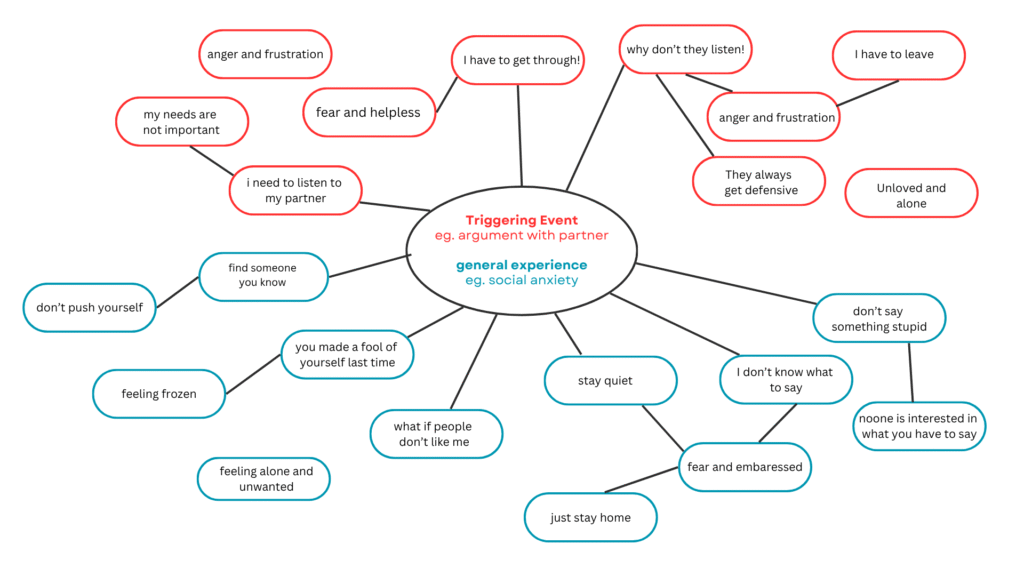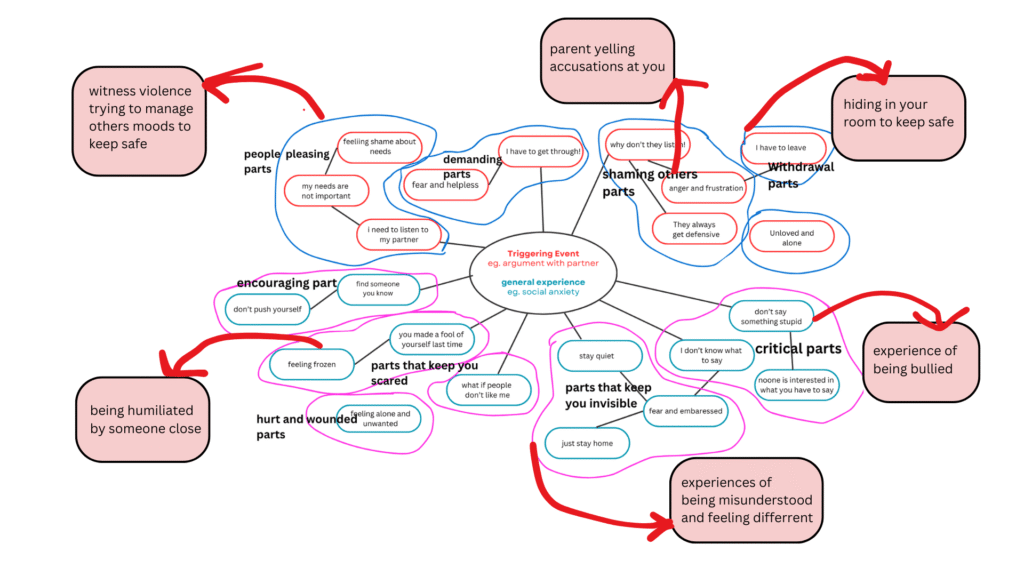🧠 Mindmapping Your System: A Parts Work Tool To Begin To Understand Your Internal System.
Mindmapping is a highly effective tool for visually noting the different “parts” within your system and tracking your progress as you explore and heal areas in therapy.
Understanding Your “Parts”
In this context, a part is anything that repeatedly responds to an internal aspect of yourself (e.g., emotions) or to an external experience (e.g., being criticised ). Its core purpose is to try to manage a situation or keep you safe.
You may commonly refer to these parts as:
- A habit, defence, or reaction.
- A trigger, compulsion, or coping strategy.
- A protection or trauma reaction.
All of these are repetitive and familiar. Upon closer examination, they link together emotions, the nervous system, beliefs, judgments, behavior, and memories. They effectively become their own system within your larger sense of self.
In IFS (and other parts work), we create a focused space to turn toward these parts with awareness, presence, and curiosity. This facilitates a witnessed, accepting presence for parts that carry shame, fear, and judgment, which ultimately helps to lift these burdens from your overall system.
Creating Your Parts Mind Map
Mindmapping is a way to create a visual representation that externalises your parts, helping you make sense of the “jumbled mess” in your head. You can be as creative as you wish, using a piece of paper and pens or a digital mind-mapping app. I used Canva to create the images below.
Step 1: Choose Your Topic
Start by choosing one specific topic, situation, or issue to explore your reactions. Write this issue in the center of the page. In the illustration below, I have identified two topics for comparison.
Step 2: Free-Flow Mapping Reactions
Begin to notice and write down the thoughts, sensations, emotions, and behaviors that arise around this topic. Link these reactions to the central topic or to each other.
- Continue noticing one thing leading to another—a thought prompting a reaction, or the opposite response.
- Notice aspects that feel linked: similar thoughts with the same purpose, or emotions and behaviors that consistently pair together.
- Come back to the topic and ask ‘What else is activated?’
Here is an example of what this might look like for ‘argument with partner’ or ‘social anxiety’. Your map will look different, even if it is the same topic.

Step 3: Group and Name Your Parts
As you come to a point where there is nothing to add for now, notice what on the map is linked together. Draw a circle or boundary around the clusters of related aspects. What you have circled is likely what we are referring to as a ‘part’. Take a look at each cluster and ask;
- What does this part want?
- Why does it do what it does?
- Is there a vulnerable part it is protecting?
You can make a note of this information for each part. You can give it a name or description.
Examples include: The Hopeful One, The Good Student, The Defeated One, The Criticising One, or The “What’s the Point” Part.
It might begin to look like this.

Step 4: Understand the Part’s Function
Once the clusters are named, continue to ask: How does this part help me? What does it manage, protect, try to prevent, or make happen?
3. Reflection and Deeper Exploration
As you look at your map, ask the following questions and listen for the answers.
- Which parts are you most interested in learning more about?
- What parts feel most “like you” (these are often the parts we identify with the most)?
- What parts do you want to disconnect from?
- What are all of these parts trying to do for you (they are all trying to deal with something)?
- Which part would create the most change in the system?
- Which part would be the easiest to focus on?
Answering these questions develops your understanding and helps you decide which part to focus on with your therapist.
4. Connecting to Memories
Early situations where we experienced harm to our authentic selves are where our wounded parts (Exiles in IFS) lie. These are the parts that could not express their pain and hurt, and our protective parts began to hide.
Memories may not be clear at first, but they can emerge as you sit with your parts or work in therapy. To explore this connection, reflect on:
- How did this part learn to do what it does?
- How far back does this part go?
- Does this part have an emotional age?
As you reflect, note any memories that surface and add them to your mind map. You may find that as you work with a part, an unexpected memory emerges—these surprises can be the most fruitful places in the work.
Important Note: If reflecting on memories feels too scary or activating, wait until you are in a therapeutic space. We want to note the connection from a safe, intellectual distance for now.
Here is an example of possible memories on the map.

Mindmapping is simply a powerful starting place to externalise your internal reactions, differentiate your parts from one another, and prepare for deeper therapeutic work.
Final thoughts.
Use a different direction from the topic to represent for or against an issue. Organise clusters on one side versus the other. Or up and down. Using post-it notes gives you a way to move them around on a whiteboard or wall.
Do what works for you and have fun.
We have several Therapists experienced in Internal Family Systems.
Neora Snitz, Leila Milani, Amanda Herron, Ocean Prasuhn, and Delyse ledgard.